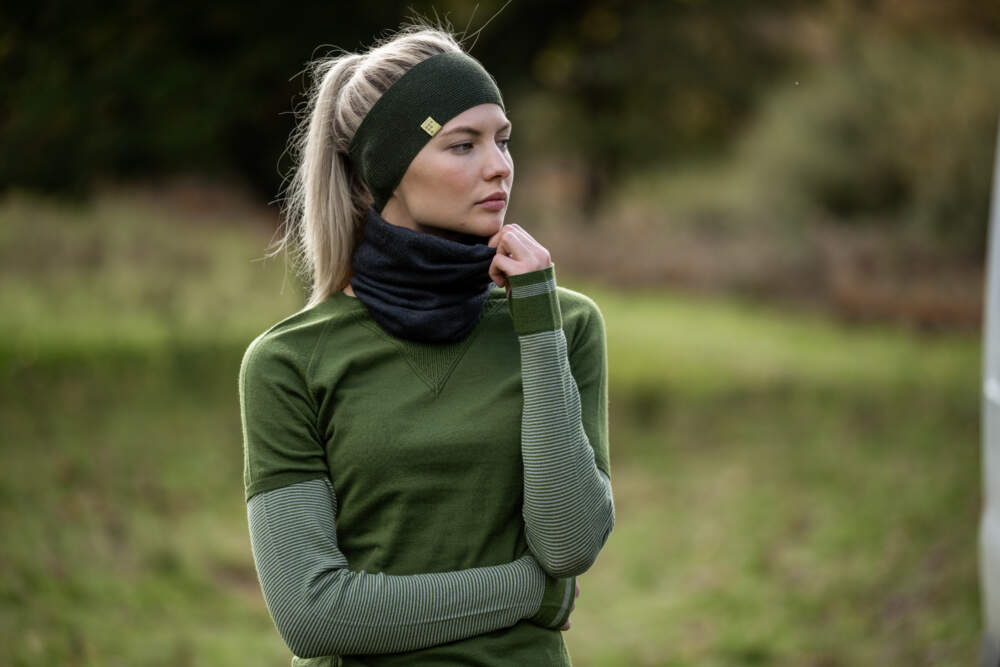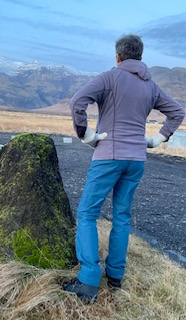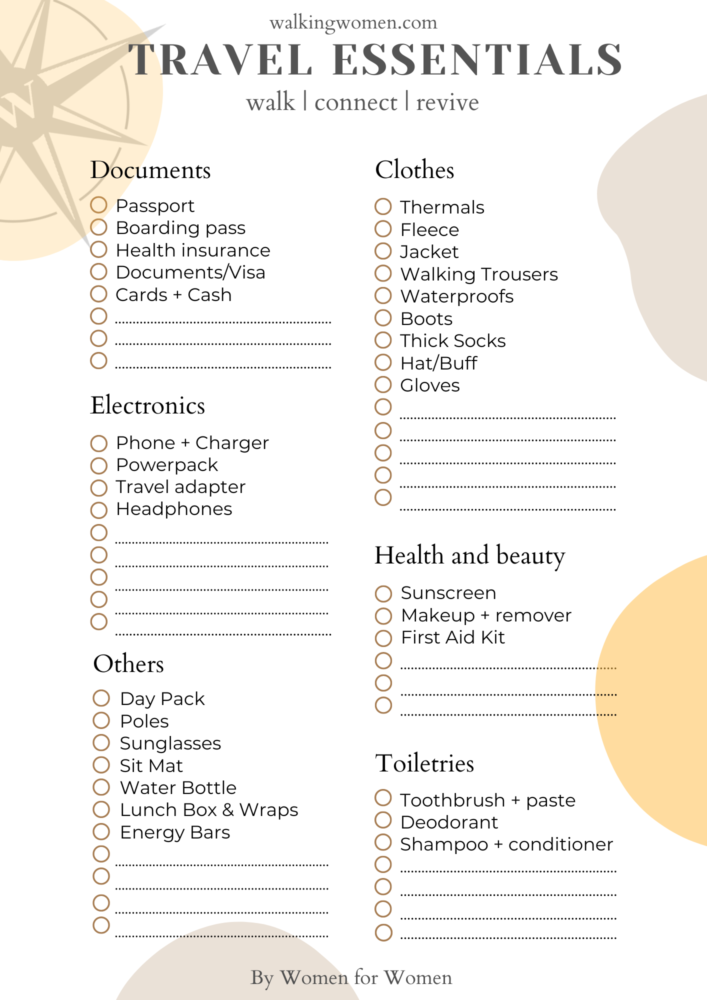At WalkingWomen, we work with experienced women guides who know their mountains and we asked them to give some top tips to help you prepare and to pack.
Wherever you are in the world weather can be quite unpredictable – it may be sunny in the valley but as you climb up in may change to rain and cold at the top, so lets be prepared !
We are giving you ideas here to ensure you have the right clothing for any season. Then each season we will let you know if there are any new items or top tips we have to share.
Keep reading to find out exactly what you need!

Let’s start with what to wear. Layering is key when it comes to dressing for hiking, as it allows you to adjust your clothing depending on the temperature and provides extra insulation against cold wind and rain or protection against high sun. We have provided this as a guide to help you be prepared. There is a huge range of technical clothing available to choose from with a vast array of prices. It is easy to spend hundreds of pounds, so it’s essential you choose wisely. We have partnered with FINDRA run by a woman and who offer sustainable clothing options, give great free advice and offer WalkingWomen a discount! Quote FINWW10 when ordering.
Its also useful to learn from others who’ve done lots of research – take a look at Cotswold Outdoors Layering Guide
Thermals are great in winter but also useful especially in the UK and you are walking up high mountains. It has been known to snow in April!
- BASE LAYERS: Thermals (Long johns & vest) – Ideally, Merino Wool is a must-have in colder temperatures, as it provides an extra layer of warmth and comfort. Merino wool is soft on the skin, breathable and very warm. There are cheaper synthetic alternatives that are effective; some options are listed below.
In warmer springs, summer you can get merino t shirts or t shirts that breath and don’t soak up sweat that leaves you cold when you cool down !
- MID LAYERS: Fleece top – a fleece top is perfect for layering up as it traps heat and helps keep out the wind chill. A full zip allows you to open up if you start heating up on the ascents.
- OUTER LAYER: Down Jackets, either down or synthetic, will keep you warm.A good fleece or soft shell,long sleeve,lightweight and moisture-wicking with a full zip is good for when its warmer. You can open up fully and avoid overheating.
- Read more – Cotswold Outdoors Guide to buying insulated jackets
Its useful to have an outer layer that can pack up small so it is easy to pop it in your day pack when you don’t need it.

- WALKING TROUSERS: Warm/windproof trousers will provide additional warmth and protection from the elements.
When walking in warmer climates or even the UK in summer then long shorts or shorts can be good for keeping cool. We like ones with lots of pockets.
- WATERPROOFS: this is essential for any outdoor activity as it keeps you dry even in wet weather conditions. Check the weather before you start your hike, but generally, the advice is to take waterproofs with you unless you are absolutely sure you won’t get wet! It was unusual but it rained on our early October Algarve holiday and not everyone had packed a waterproof. Our guide suggests a breathable waterproof jacket with a hood and to buy slightly bigger than you wear so you can fit more layers underneath. Don’t forget you can spray your jacket and re proof it.

- FOOTWEAR: Rigid-soled winter boots – these are designed specifically for walking in snowy or icy conditions, providing extra grip and support while keeping your feet warm.
- A ‘ Vibram” sole is recommended for uneven ground as they are not so easy to bend.
- When it is dry walking shoes can be a nice change – light and easy to wear.
- It’s impossible for us to recommend any specific boots as it is such a personal choice. Most outdoor shops will let you walk around and will advise.
- SOCKS: DO NOT SKIMP ON CHEAP SOCKS. We can’t stress this enough. Good quality thick wool socks will reduce the chance of blisters and keep your feet warm and comfortable. We like Bridgedale Women’s Merino Hiker Socks. You can see the whole collection here.
- GAITERS (optional) – gaiters are great for protecting your lower legs from mud or wet snow that might otherwise seep into your boots and make them uncomfortable.
- HAT – a warm hat is essential in cold weather as most of our body heat escapes through our head! In the sun then a sun hat to protect you from hours of rays and to prevent over heating.
- GLOVES OR MITS in the winter will help keep your hands warm while allowing flexibility of movement – [buying guide]
⇒ TIP: Check the label for washing instructions when washing wool socks and Marino wool garments. If you wash them on a hot wash, you will end up with clothing fit for a Barbie doll!! That’s an expensive mistake you don’t want to make!
WHAT TO TAKE ON THE TRAILS
- A DAYPACK – Assuming you’re not planning to wild camp or go hiking unsupported for days on end, a 20l to 26l day pack should suffice. Outer pockets are useful for keeping snacks, tissues, and other essentials can be useful. Make sure it’s waterproof or comes with a waterproof cover. – Read Cotswold Outdoor Best Pack Guide
- POLES– Poles are helpful if you’re walking over uneven terrain or unstable ground. They provide extra balance and stability while reducing strain on your joints.

- SIT MAT: These are great for keeping you’re bum dry when sitting on damp ground. Light and packable, it’s worth making room in your pack for one.
- SMALL FIRST AID KIT: If you are accompanied by our guides, they will carry a full first aid kid, but we always recommend you carry the basics in your pack, especially if you are hiking in remote areas. The essentials are blister plasters,maybe vasoline, painkillers, and a survival blanket. Insect repellent with DEET in it is useful if going somewhere with biting insects!
- WATER BOTTLE: It’s essential to take water with you when walking, and we would suggest, rather than taking a plastic water bottle, investing in a reusable, more sustainable option is a good idea.
- LUNCH BOX AND RECYCLED WAX WRAPS: Not essential, but really useful to stop your packed lunch from getting squished.
- ENERGY GELS – If you have a challenging day ahead, it’s worth throwing in a couple of energy bars or gels to ensure you stay well-fuelled throughout the day.
⇒ TIP: Rather than paying a premium for ‘energy’ bars/gel, take Jelly Babies or Fruit Pastels along with a handful of fig rolls – it does the job at half the price! - PHONE & POWERPACK – if you planning to track your route on your phone or take lots of pics, it’s worth carrying a power pack with you.
- BUFF – We love Buffs. They are so versatile and light to pack. They can be used as scarves, headbands or hats and come in various colours.
- SUNGLASSES – Remember, if there is snow around and the sun comes out, it can become very bright. Or if you are walking in a hot summer destination. Sunscreen , lip balm also essential.
With these items in tow, you’ll be ready to take on anything Mother Nature throws at you! Remember to layer up correctly so you can adjust according to the temperature outside. If you follow this kit list, nothing will stand between you and an incredible outdoor adventure! Happy hiking and we hope to see you soon on a WalkingWomen Adventure!
O and if you just want some lounge wear post hiking we have made some cosy sweatshirts and cotton t shirts for your down time. Do visit our online shop.
⇒ TIP: Old Boots and waterproofs can be treated to reproof them. You may be able to resurrect old gear saving you money and being more sustainable – see Cotswold Outdoor’s guide to making adventures more sustainable
Download and print our handy Travel Essentials pack list here.


